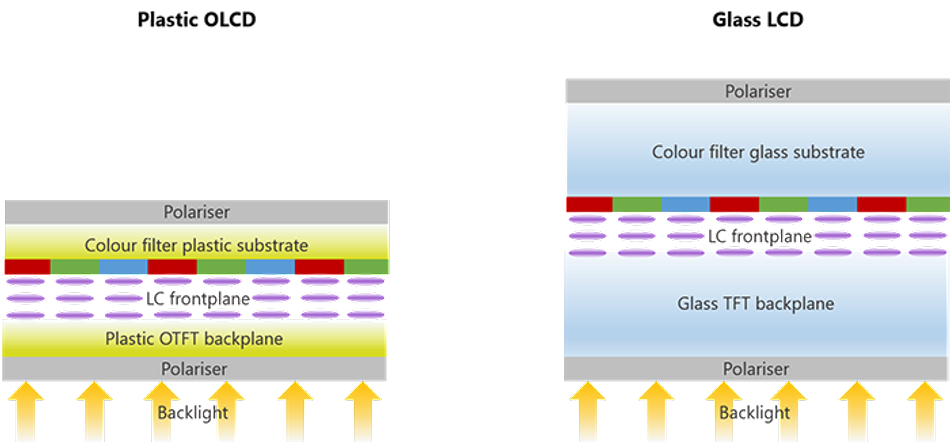Why certain plastic substrates are an ideal alternative to glass for LCD
Plastic substrates for flexible displays are well known for their mechanical benefits such as thinness, lightness and flexibility, but their optical advantages are less cited.
Plastic substrates for flexible displays are well known for their mechanical benefits such as thinness, lightness and flexibility, but their optical advantages are less cited. This blog post aims to shed light on the optical advantages of using plastic substrates as an alternative to glass for LCD.
Plastic LCD vs glass LCD
Before I describe the optical advantages of plastic substrates, I should briefly explain the structure of a glass LCD and that of a plastic LCD and how they compare in terms of thinness and lightness.
Glass LCDs consist of a glass backplane containing the thin-film transistors (TFTs) and a glass frontplane containing the colour filter. In between these sheets of glass is the liquid crystal (LC) cell – the optical switch that shutters the light from passing through to the viewer.
The thickness of these glass sheets can vary depending on the size and performance of the display and is often in the range of 400-700 microns (μm) for each glass sheet, during processing. For some high-end ultra-slim LCDs the 400μm glass can be further thinned in post-processing down to 200μm – allowing for thinner notebooks and tablets, for example.
Organic LCDs (OLCD) consist of organic TFTs built directly onto a plastic film and commonly use a plastic called tri-acetyl cellulose (TAC) film for the substrate which is typically just 40μm thick. For a 13” notebook screen, for example, moving from glass to TAC can reduce thickness and weight by at least 0.5mm and 100g respectively.
Optical advantages of plastic LCD
The mechanical advantages of plastic OLCD over glass LCD are further enhanced by the technology’s excellent optical performance, much of which originates from the extreme thinness of plastic TAC substrates compared to glass.
Improved image quality
There’s a common optical effect in displays that reduces image quality, called sparkle. You may not have heard of it, but you’re probably familiar with it. Have you ever seen the little coloured pixels on your smartphone screen when a drop of water lands on the surface? This happens as a result of refraction, causing the viewer to perceive the pixels in a different location to their actual positon. The same effect occurs in a more subtle way with a dry screen because of surface imperfections on the front of the display, such as scratches or other roughness, causing the perceived location of the pixel beneath the glass to be changed.
A similar effect can be seen when you are standing in a swimming pool trying look down at your feet - the apparent location appears to move around as a result of the surface ripples on the water. However, in much shallower water the effect is significantly reduced. For the same reason, moving to thinner plastic substrates in displays naturally reduces the degree of sparkle that is seen – meaning a crisper uniform image on the display compared to glass-based displays.
High contrast TVs and monitors
Over the past decade LCD display contrast, particularly in TVs has continued to improve. LCD displays work by having a bright light source (backlight) sitting under the liquid crystal display pixels. Each pixel (cell) is like a window with a pair of curtains that can be opened and closed to let the backlight through - making that pixel bright or dark. However, with LCD displays, even when the curtains are completely closed, a very small amount of light still gets through, which limits how black the display can appear.
Nevertheless, LCD has continued to improve its ability to show black. In recent years this has been achieved with more sophisticated backlights that contain local dimming – allowing the brightness of the light to reduce in areas of the display where the curtains all needed to be closed (fully or partially). This is achieved by having an array of LEDs across the backlight that can be individually controlled in brightness.
The ideal scenario would be to introduce ‘pixel-level dimming’ – where every pixel (or every few pixels), has a controllable LED light source behind it. However, this is extremely expensive to do and would require several million LEDs in each TV.
An alternative to this is the so called “dual cell” structure where one display pixel (cell) is placed on top of a second display pixel. This is equivalent to having two pairs of curtains in your window – akin to a blackout blind. This means a simple, low-cost backlight can be used, and excellent blacks can be achieved. These sorts of dual cell structures have been built on glass for some time. However, combining two conventional cells requires four sheets of glass – making the TV thicker, more costly, and causing other performance limitations.
For an OLCD that uses 40μm TAC film this means that ultra-high contrast dual cells can be built and still be thinner than today’s ‘single cell’ glass LCDs, and can be manufactured in a simpler way at lower cost with higher optical performance.


